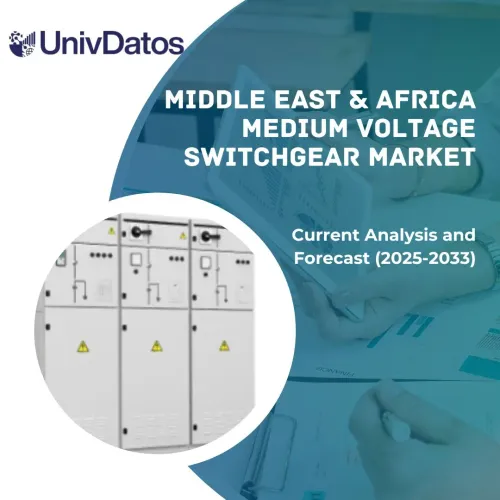- Startseite
- Über uns
- Industrie
- Dienstleistungen
- Lesen
- Kontaktieren Sie uns
Grüner Wasserstoffmarkt: Aktuelle Analyse und Prognose (2023-2030)
Schwerpunkt auf Elektrolyseur (Protonenaustauschmembran-Elektrolyseur, Alkali-Elektrolyseur, Andere); Quelle (Solarenergie, Windenergie, Andere); Endverbraucher (Raffinerie, Ammoniak, Andere); und Region/Land
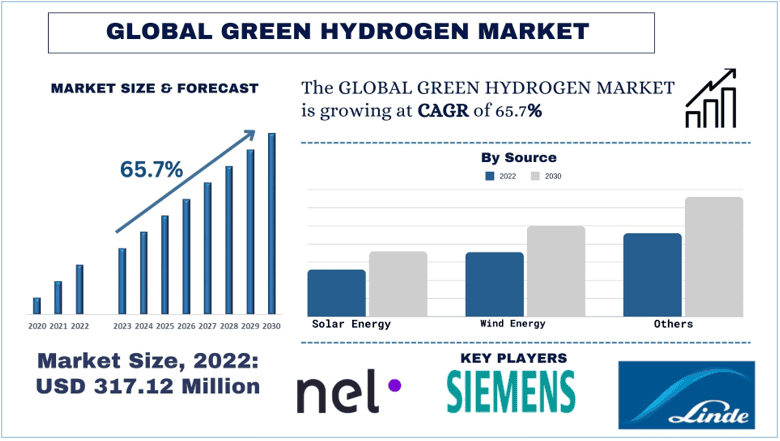
Green Hydrogen Marktgröße & Prognose
Der Green Hydrogen Markt wurde auf USD 317,12 Millionen geschätzt und wird voraussichtlich mit einer starken CAGR von rund 65,7 % während des Prognosezeitraums (2023-2030) wachsen, was auf die von den Ländern weltweit festgelegten Netto-Null-Emissionsziele für 2030 zurückzuführen ist, um den Übergang zu erneuerbaren Energien zu fördern.
Green Hydrogen Marktanalyse
Der globale Green Hydrogen Markt bedient seit einigen Jahren eine erhebliche Marktnachfrage. Faktoren, die sein Wachstum antreiben, sind die von den Ländern weltweit festgelegten Netto-Null-Emissionsziele für 2030, um den Übergang zu erneuerbaren Energien zu fördern. Darüber hinaus beschleunigen die unterstützenden Regierungsrichtlinien, Programme, Subventionen und Investitionen in Anlagen zur Produktion von grünem Wasserstoff die Marktgröße von grünem Wasserstoff weltweit weiter. Darüber hinaus arbeiten verschiedene wichtige Akteure im Bereich der erneuerbaren Energien zusammen, um den Preis von Elektrolyseuren zu senken, was letztendlich die Gesamtkosten der grünen Wasserstoffproduktion senken wird. Zum Beispiel: Im Jahr 2024 ging Schneider Electric eine Partnerschaft mit Hy Stor Energy ein, um die Entwicklung des Mississippi Clean Hydrogen Hub (MCHH) und seiner breiteren US-Entwicklungsplattform zu unterstützen.
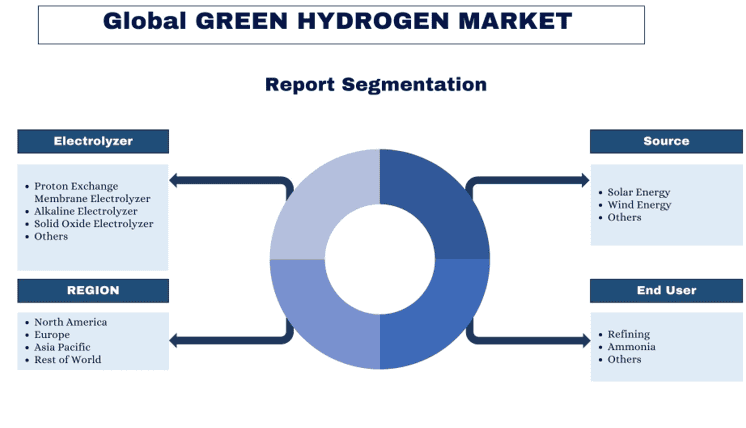
Green Hydrogen Markttrends
Zunehmende Investitionen und Zusagen von Regierungen, um die Produktion und Infrastruktur von grünem Wasserstoff auszubauen
Eines der bemerkenswertesten Beispiele für diesen Trend ist die ehrgeizige Wasserstoffstrategie der Europäischen Union, die im Jahr 2020 vorgestellt wurde und darauf abzielt, eine grüne Wasserstoffwirtschaft zu entwickeln, um bis 2050 Klimaneutralität zu erreichen. Die EU hat sich verpflichtet, massiv in die Produktion und Infrastruktur von grünem Wasserstoff zu investieren, einschließlich der Einrichtung von Wasserstofftälern und der Entwicklung von Elektrolyseurkapazitäten. Im Jahr 2021 unternahm die EU mit verschiedenen Initiativen und Förderprogrammen weitere Schritte in diese Richtung, um das Wachstum des Green Hydrogen Marktes zu unterstützen.
Eine weitere wichtige Entwicklung auf dem Green Hydrogen Markt im Jahr 2021 war die wachsende Zusammenarbeit zwischen Regierungen, Industrien und anderen Interessengruppen, um die Einführung von grünem Wasserstoff voranzutreiben. So schlossen beispielsweise mehrere Länder strategische Partnerschaften und Allianzen, um die Produktion, den Vertrieb und die Nutzung von grünem Wasserstoff zu fördern. Ein solches Beispiel ist die Gründung der Green Hydrogen Catapult Initiative durch ein Bündnis von Energieunternehmen und Regierungen mit dem Ziel, die Kosten für grünen Wasserstoff zu senken, um seinen breiten Einsatz zu ermöglichen.
Darüber hinaus erlebte das Jahr 2021 einen Anstieg der Investitionen in grüne Wasserstoffprojekte und -technologien, da die Akteure das immense Potenzial von grünem Wasserstoff als Schlüsselfaktor für die Energiewende erkannten. Im Jahr 2021 wurden mehrere hochkarätige Projekte angekündigt oder begonnen, die die zunehmende kommerzielle Tragfähigkeit und Skalierbarkeit von grünem Wasserstoff demonstrieren. Zum Beispiel erhielt das AquaVentus-Projekt in Deutschland, eines der weltweit größten Offshore-Wind-zu-Wasserstoff-Projekte, erhebliche Mittel und Unterstützung für die Entwicklung einer großtechnischen Anlage zur Produktion von grünem Wasserstoff mit Offshore-Windkraft.
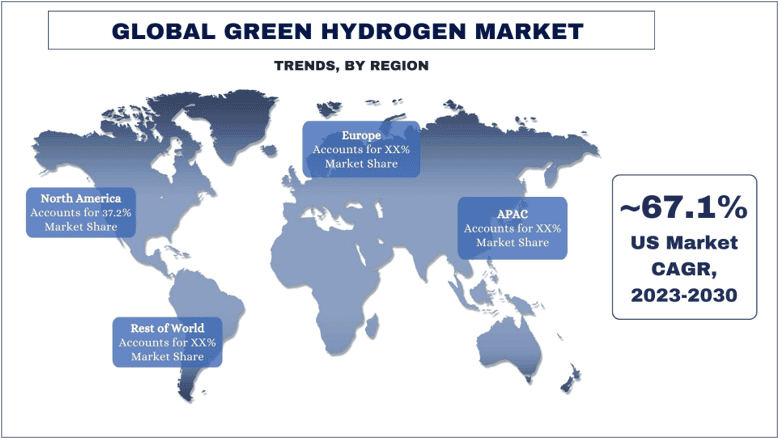
Nordamerika wird voraussichtlich mit einer signifikanten CAGR während des Prognosezeitraums wachsen
Der Green Hydrogen Markt in Nordamerika hat in den letzten Jahren ein signifikantes Wachstum erlebt. Dies ist hauptsächlich auf die laufende operative Anlage für grünen Wasserstoff zurückzuführen, die darauf abzielt, den Bedarf an grünem Wasserstoff zu decken, insbesondere für Transportanwendungen. Zum Beispiel: Im Jahr 2024 nahm H2B2 Electrolysis Technologies, ein internationaler Hersteller von grünem Wasserstoff, den Betrieb von SoHyCal auf, der größten Anlage zur Produktion von grünem Wasserstoff, die vollständig mit erneuerbarer Energie in Nordamerika betrieben wird. Darüber hinaus arbeiten wichtige Akteure in der Region zusammen, um die Entwicklung von Anlagen zur Produktion von grünem Wasserstoff zu unterstützen. Zum Beispiel: Im Jahr 2024 arbeiteten Hy Stor Energy und Schneider Electric zusammen, um die integrierte, netzunabhängige Produktion von grünem Wasserstoff und die Energiespeicherung in großem Maßstab voranzutreiben. In dieser Partnerschaft lösen Schneider Electric und Hy Stor Energy große Herausforderungen in den Bereichen Energie und Nachhaltigkeit, die für den Übergang zu einem erneuerbaren und fossilfreien Energiesystem erforderlich sind. Ebenso sind StormFisher Hydrogen und kiwi AG im Jahr 2024 eine Partnerschaft eingegangen, um die Entwicklung von Projekten im Zusammenhang mit grünem H2 in Nordamerika und Europa voranzutreiben.
Green Hydrogen Branchenüberblick
Der Green Hydrogen Markt ist wettbewerbsintensiv und fragmentiert, mit der Präsenz mehrerer globaler und internationaler Marktteilnehmer. Die wichtigsten Akteure verfolgen verschiedene Wachstumsstrategien, um ihre Marktpräsenz zu verbessern, wie z. B. Partnerschaften, Vereinbarungen, Kooperationen, neue Produkteinführungen, geografische Expansionen sowie Fusionen und Übernahmen. Einige der wichtigsten Akteure, die auf dem Markt tätig sind, sind NEL ASA, ITM Power, Engie, Siemens, Air Products Inc., Messer Group GMBH, Plug Power Inc., Cummins Inc., Air Liquide und Linde.
Green Hydrogen Markt News
- Im Januar 2023 unterzeichneten Nel und Statkraft einen Vertrag über die Lieferung von 40 MW Elektrolyseurausrüstung mit dem Ziel, eine starke Wertschöpfungskette für die Produktion von grünem Wasserstoff in Norwegen zu schaffen.
- Im Mai 2023 ging Siemens Energy eine Partnerschaft mit Edify Energy ein, um eine Anlage zur Produktion von 100 % grünem Wasserstoff in Queensland zu entwickeln.
- Im Oktober 2023 haben Engie und Posco eine Vereinbarung zur Zusammenarbeit an einem großen Projekt für grünen Wasserstoff in der Pilbara-Region in Westaustralien unterzeichnet.
Green Hydrogen Marktbericht Abdeckung
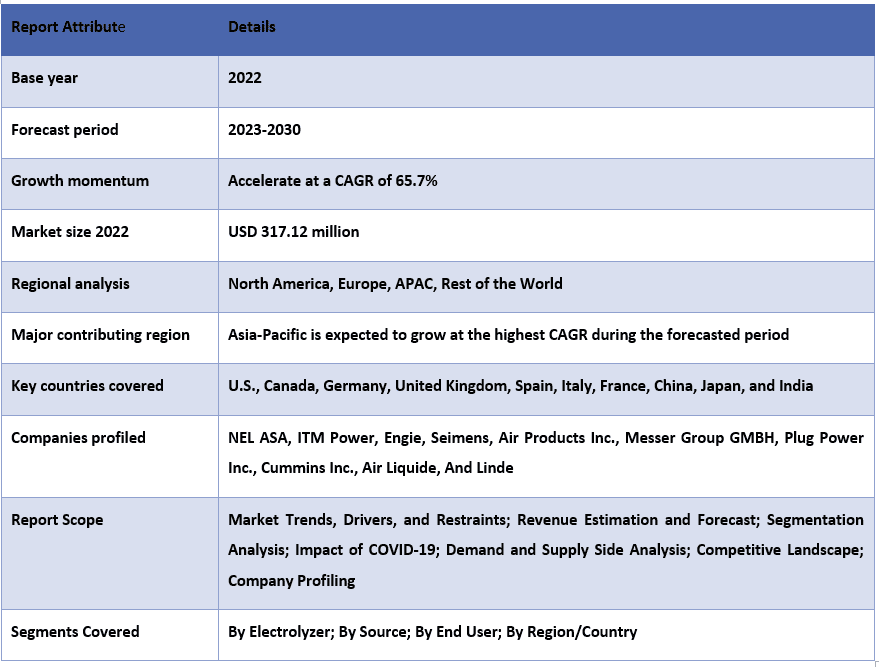
Gründe für den Kauf dieses Berichts:
- Die Studie umfasst eine Analyse der Marktgröße und -prognose, die von authentifizierten wichtigen Branchenexperten validiert wurde.
- Der Bericht bietet einen schnellen Überblick über die Gesamtleistung der Branche auf einen Blick.
- Der Bericht enthält eine detaillierte Analyse der wichtigsten Branchenkollegen mit einem primären Fokus auf wichtige Finanzdaten, Produktportfolios, Expansionsstrategien und aktuelle Entwicklungen.
- Detaillierte Untersuchung der Treiber, Einschränkungen, wichtigsten Trends und Chancen in der Branche.
- Die Studie deckt den Markt umfassend über verschiedene Segmente hinweg ab.
- Tiefgehende regionale Analyse der Branche.
Anpassungsoptionen:
Der globale Green Hydrogen Markt kann weiter an die Anforderungen oder jedes andere Marktsegment angepasst werden. Darüber hinaus versteht UMI, dass Sie möglicherweise Ihre eigenen geschäftlichen Anforderungen haben. Zögern Sie daher nicht, sich mit uns in Verbindung zu setzen, um einen Bericht zu erhalten, der Ihren Anforderungen vollständig entspricht.
Inhaltsverzeichnis
ForschungsMethodik für die Green hydrogen Markt Analyse (2023-2030)
Die Analyse des historischen Marktes, die Schätzung des aktuellen Marktes und die Prognose des zukünftigen Marktes des globalen Green hydrogen Marktes waren die drei wichtigsten Schritte, die unternommen wurden, um die Einführung von Green hydrogen in wichtigen Regionen weltweit zu erstellen und zu analysieren. Es wurde eine umfassende Sekundärforschung durchgeführt, um die historischen Marktzahlen zu sammeln und die aktuelle Marktgröße zu schätzen. Zweitens wurden zahlreiche Erkenntnisse und Annahmen berücksichtigt, um diese Erkenntnisse zu validieren. Darüber hinaus wurden umfassende Primärinterviews mit Branchenexperten entlang der Wertschöpfungskette des globalen Green hydrogen Marktes geführt. Nach Annahme und Validierung der Marktzahlen durch Primärinterviews haben wir einen Top-Down/Bottom-Up-Ansatz zur Prognose der Gesamtmarktgröße angewendet. Danach wurden Marktaufschlüsselungs- und Datentriangulationsmethoden angewendet, um die Marktgröße von Segmenten und Subsegmenten der Branche zu schätzen und zu analysieren. Die detaillierte Methodik wird im Folgenden erläutert:
Analyse der historischen Marktgröße
Schritt 1: Eingehende Untersuchung sekundärer Quellen:
Es wurde eine detaillierte Sekundärstudie durchgeführt, um die historische Marktgröße des Green hydrogen Marktes aus unternehmensinternen Quellen wie Jahresberichten und Finanzberichten, Leistungspräsentationen, Pressemitteilungen usw. und externen Quellen wie Fachzeitschriften, Nachrichten und Artikeln, Regierungsveröffentlichungen, Wettbewerbsveröffentlichungen, Sektorberichten, Datenbanken von Drittanbietern und anderen glaubwürdigen Publikationen zu erhalten.
Schritt 2: Marktsegmentierung:
Nachdem wir die historische Marktgröße des Green hydrogen Marktes erhalten hatten, führten wir eine detaillierte Sekundäranalyse durch, um historische Markteinblicke und Anteile für verschiedene Segmente und Subsegmente für wichtige Regionen zu sammeln. Die wichtigsten Segmente, die in dem Bericht enthalten sind, sind Elektrolyseur, Quelle und Endverbraucher. Darüber hinaus wurden Analysen auf Länderebene durchgeführt, um die allgemeine Akzeptanz von Testmodellen in dieser Region zu bewerten.
Schritt 3: Faktorenanalyse:
Nachdem wir die historische Marktgröße verschiedener Segmente und Subsegmente ermittelt hatten, führten wir eine detaillierte Faktorenanalyse durch, um die aktuelle Marktgröße des Green hydrogen Marktes zu schätzen. Darüber hinaus führten wir eine Faktorenanalyse unter Verwendung abhängiger und unabhängiger Variablen wie Elektrolyseur, Quelle und Endverbraucher des Green hydrogen Marktes durch. Es wurde eine gründliche Analyse der Nachfrage- und Angebotsseite unter Berücksichtigung von Top-Partnerschaften, Fusionen und Übernahmen, Geschäftsausweitungen und Produkteinführungen im Green hydrogen Marktsektor weltweit durchgeführt.
Aktuelle Marktzufallsschätzung & Prognose
Aktuelle Marktgrößenbestimmung: Basierend auf den umsetzbaren Erkenntnissen aus den oben genannten 3 Schritten haben wir die aktuelle Marktgröße, die wichtigsten Akteure im globalen Green hydrogen Markt und die Marktanteile der Segmente ermittelt. Alle erforderlichen prozentualen Anteile und Marktaufschlüsselungen wurden unter Verwendung des oben genannten sekundären Ansatzes ermittelt und durch Primärinterviews verifiziert.
Schätzung & Prognose: Für die Marktschätzung und -prognose wurden verschiedene Faktoren, einschließlich Triebkräfte & Trends, Beschränkungen und Chancen, die den Stakeholdern zur Verfügung stehen, gewichtet. Nach der Analyse dieser Faktoren wurden relevante Prognosetechniken, d. h. der Top-Down/Bottom-Up-Ansatz, angewendet, um die Marktprognose für 2030 für verschiedene Segmente und Subsegmente in den wichtigsten Märkten weltweit zu erstellen. Die Forschungsmethodik zur Schätzung der Marktgröße umfasst:
- Die Marktgröße der Branche in Bezug auf den Umsatz (USD) und die Akzeptanzrate des Green hydrogen Marktes in den wichtigsten Märkten im Inland
- Alle prozentualen Anteile, Aufteilungen und Aufschlüsselungen von Marktsegmenten und Subsegmenten
- Wichtige Akteure im globalen Green hydrogen Markt in Bezug auf die angebotenen Produkte. Außerdem die Wachstumsstrategien, die von diesen Akteuren angewendet werden, um in dem schnell wachsenden Markt zu konkurrieren
Validierung der Marktgröße und des Marktanteils
Primärforschung: Es wurden eingehende Interviews mit den Key Opinion Leaders (KOLs) geführt, darunter Top Level Executives (CXO/VPs, Vertriebsleiter, Marketingleiter, Betriebsleiter, Regionalleiter, Länderchef usw.) in den wichtigsten Regionen. Die Ergebnisse der Primärforschung wurden dann zusammengefasst und eine statistische Analyse durchgeführt, um die aufgestellte Hypothese zu beweisen. Die Inputs aus der Primärforschung wurden mit den sekundären Erkenntnissen zusammengeführt, wodurch Informationen in umsetzbare Erkenntnisse umgewandelt wurden.
Aufteilung der Primärteilnehmer in verschiedenen Regionen
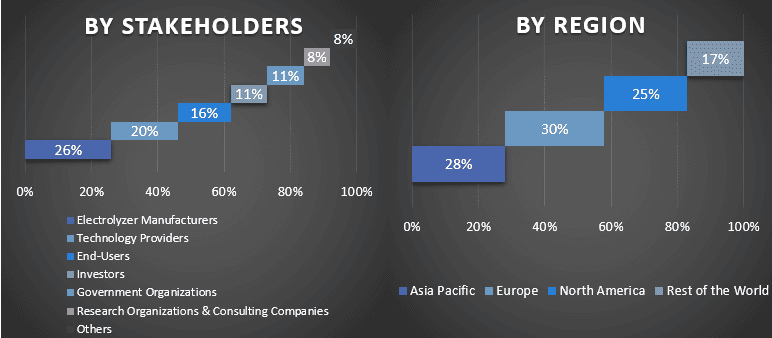
Green hydrogen Markt
Market Engineering
Die Datentriangulationstechnik wurde verwendet, um die Gesamtmarktschätzung abzuschließen und präzise statistische Zahlen für jedes Segment und Subsegment des globalen Green hydrogen Marktes zu erhalten. Die Daten wurden in mehrere Segmente und Subsegmente aufgeteilt, nachdem verschiedene Parameter und Trends in den Bereichen Elektrolyseur, Quelle und Endverbraucher im globalen Green hydrogen Markt untersucht worden waren.
Das Hauptziel der Global Green hydrogen Marktstudie
Die aktuellen und zukünftigen Markttrends des globalen Green hydrogen Marktes wurden in der Studie genau bestimmt. Investoren können strategische Einblicke gewinnen, um ihre Entscheidungen für Investitionen auf der Grundlage der in der Studie durchgeführten qualitativen und quantitativen Analyse zu treffen. Aktuelle und zukünftige Markttrends bestimmten die Gesamtattraktivität des Marktes auf regionaler Ebene und boten den Industrieteilnehmern eine Plattform, um den unerschlossenen Markt zu nutzen und von einem First-Mover-Vorteil zu profitieren. Weitere quantitative Ziele der Studien sind:
- Analyse der aktuellen und prognostizierten Marktgröße des Green hydrogen Marktes in Bezug auf den Wert (USD). Analyse der aktuellen und prognostizierten Marktgröße verschiedener Segmente und Subsegmente
- Die Segmente der Studie umfassen die Bereiche Elektrolyseur, Quelle und Endverbraucher
- Definition und Analyse des regulatorischen Rahmens für die Green hydrogen Industrie
- Analyse der Wertschöpfungskette mit der Präsenz verschiedener Vermittler sowie Analyse des Kunden- und Wettbewerberverhaltens der Branche
- Analyse der aktuellen und prognostizierten Marktgröße des Green hydrogen Marktes für die Hauptregion
- Zu den wichtigsten Ländern der in dem Bericht untersuchten Regionen gehören der asiatisch-pazifische Raum, Europa, Nordamerika und der Rest der Welt
- Unternehmensprofile des Green hydrogen Marktes und die von den Marktteilnehmern angewandten Wachstumsstrategien, um sich in dem schnell wachsenden Markt zu behaupten
- Tiefgehende regionale Analyse der Branche
Häufig gestellte Fragen FAQs
F1: Wie groß ist die aktuelle Marktgröße und das Wachstumspotenzial des Marktes für grünen Wasserstoff?
F2: Was sind die treibenden Faktoren für das Wachstum des Marktes für grünen Wasserstoff?
F3: Welches Segment hat den größten Anteil am Markt für grünen Wasserstoff nach Elektrolyseur?
F4: Was sind die aufkommenden Technologien und Trends auf dem Markt für grünen Wasserstoff?
F5: Welche Region wird den Markt für grünen Wasserstoff dominieren?
Verwandt Berichte
Kunden, die diesen Artikel gekauft haben, kauften auch






